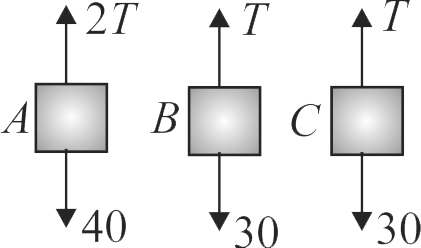Explanation:
\(F.B.D.\) of the blocks \({A, B}\) and \({C}\)

Conditions of forces on \({B}\) and \({C}\) are same so they both will move with same downward acceleration \({a}\). The block \({A}\) moves with the same acceleration \({a}\) upwards
From block \(A:2T - 40 = 4a\,\,\,\,\,\,\,\,\,\,\,\,\,\,\,\,\,\,\,\,\,\,\,\,\,\,\,\,\,\,\,\,\,\,\,\,\left( 1 \right)\)
From block \({B}\) or \(C:30 - T = 3a\,\,\,\,\,\,\,\,\,\,\,\,\,\,\,\,\,\,\,\,\,\,\,\,\,\left( 2 \right)\)
From above two equations \({a=2 {~m} / {s}^{2}}\)